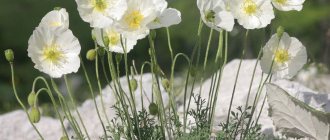When creating flower beds, flower beds and alpine slides in their garden plots, most flower growers does not forget to plant garden violets, usually using several varieties to complete the picture.
These small plants
attract attention with their variety of colors against the backdrop of lush greenery and enchant with their delicate, fragile flowers and subtle trail of aroma.
And the unpretentiousness of violets helps them gain even greater popularity among gardeners and landscape designers. In the article you will learn in detail how garden violets grow - descriptions and photos of various types.
What does garden violet mean?
People have been admiring the delicate charm of violets for almost two and a half millennia, but they began to be purposefully grown and propagated to decorate gardens and parks relatively recently :
Violets have recently begun to be grown in gardens.
- In European countries, violet has been known as a garden plant since the beginning of the 16th century;
- In Russia - since the 18th century.
INFORMATIVE! Violets propagated for growing near human habitations are united by flower growers into a conventional group of garden violets. The synonymous series of this group, in addition to the name “Garden Violet”, includes the names “Viola”, “Pansy” and simply “Violet”.
One species or a group of different species and varieties?
Over several centuries of active cultivation of violets by flower growers of the Old World and Russia, many new species were bred - by the beginning of the 21st century, according to the Royal Horticultural Society (Great Britain), 21 species were used in gardening and landscape art.
Based on the basic species, breeders continue to grow magnificent varieties and hybrids of violas, differing in :
- Bright colors;
- Lasting aroma;
- And large flowers.
One species of garden pansy (Wittrock's viola) alone has about 500 bred forms .
Also, do not forget that white violet will look very beautiful and delicate in your gardens. The whole variety of violets used to decorate garden plots and public parks are usually called garden violets .
The most beloved and most common among garden violets are hybrid varieties of the species Viola Wittrock , called garden pansies by gardeners.
In addition, quite popular types :
- F. Graceful;
- F. Rogataya;
- F. Chinese (Manjurian);
- F. Labrador;
- F. Motley and some others.
Varieties of perennial violets
The following varieties and hybrids bred on their basis are the most common and beloved by gardeners.
Fragrant
The leaves grow in a bunch on stems 10-18 centimeters high. Viola odorata is a fragrant plant; flowers (girth up to 30 mm) can have a simple or double structure. The color is usually blue, purple or lilac. In the evening the aroma intensifies. It is propagated by cuttings, has a creeping stem and takes root well.
Horned
It received its name for the characteristic growth behind the inflorescence. Viola cornuta grows up to 22 centimeters in height, and the flowers have a coverage of up to 4 centimeters and much more.
Based on this species, many differently colored hybrids have been bred. These varieties are often cultivated as biennials - the seeds are sown directly into the ground in summer or autumn, and lush flowering is observed the following year.
Description of varieties
Despite the numerous species and varieties of garden violets, they have a significant number of characteristic features :
- Garden violets are mostly low herbaceous plants or small bushes;
- Many varieties have basal leaf rosette due to a shortened stem, but some are distinguished by the usual structure of the stem - then the alternate arrangement of leaves is clearly visible;
There are many colors of garden violets.
- Whole, less often weakly dissected leaves acquire an oval, heart-shaped or lobed shape. Some varieties have thick downy feathers on the leaves;
- Violet flowers are formed singly from the axils of the leaves on high stalks;
- The corolla necessarily consists of 5 petals , resembling a moth in appearance. The lower, larger petal is located in the center and rests on two sepals, the next two petals, somewhat smaller in size, sit on the sides of the lower one and each have their own sepals. The two upper petals are usually the smallest - the last sepal remains for them;
- The flowers often bear a special spur;
- The color range of violet corollas includes all possible shades of the rainbow.
Let's find out how to plant and care for perennial garden violets. You can see a photo of two-year-old Viola below.
Some varieties of biennial viola.
To facilitate their classification, all the variety of forms of garden violets are divided according to their distinctive characteristics. One of the gradation factors is the life expectancy of the plant, according to which the following groups are identified :
- Annuals - grown from seeds, live for one year, are a herbaceous plant. These include tricolor violet (can be cultivated as a biennial plant);
- Biennials - grown from seeds or cuttings, bloom in the second year, can be herbaceous or bushy. These are Viola tricolor (sometimes grown as an annual), hybrids of Wittrock's viola, as well as many perennial violets, which gardeners prefer to cultivate as a biennial;
- Perennial - grow in the form of a small bush, propagate both by seed and by cuttings or dividing the bush; they can form large clumps due to integumentary growth. The fragrant perennial garden violet has smaller buds, but blooms more profusely than the annual one. Representatives: Horned, Moth, Labrador violets.
Growing conditions
Garden violet prefers sunny or slightly shaded places that have fertile, well-drained soil. In dry weather, the plant needs watering, otherwise the flowers become smaller and flowering may stop altogether.
Despite the fact that violets are moisture-loving plants, they cannot tolerate excess moisture and can simply die during the spring thaw.
This plant easily tolerates light shading or diffused light, but the formation of many flowers and abundant flowering is possible only in a well-lit area. In places that are hidden from the sun and exposed to dampness, violets can be damaged by slugs.
The perennial garden violet is increasingly winning the souls of gardeners. They only grow it as an annual or biennial. For the most part, this is due to the fact that over time, the violet stems become very elongated and the flowers decrease in size. It is obvious to everyone that it is easier and faster to plant new plants.
Planting and care
Few gardeners know when to replant garden violets. Various forms of garden violets are mostly unpretentious plants ; only some hybrids may place increased demands on certain aspects of maintenance.
Optimal location
According to their biological characteristics, garden violets can be classified as sun-loving plants with the only caveat that on hot summer days the flowers still need some shading, otherwise the leaves may wilt and darken.
Violas can easily grow in partial shade, but when planting them in prefabricated flower beds, it is better to carefully consider the types of violet companions so that too tall specimens do not cover it from the sun's rays as they grow.
ATTENTION! Only very shady corners of household plots are not suitable for garden violets, since due to lack of light the corollas of plants can become smaller and pale, and it is also possible to be attacked by slugs that prefer shade.
The ideal location for planting violets would be any well-lit or slightly shaded area of the garden with sufficiently nutritious soil. If these conditions are met, the violet will bloom abundantly.
Suitable land
The health, decorativeness and long-term flowering of garden violas directly depend on the selected soil quality . A substrate for violets needs to be rich in nutrients, but at the same time quite loose, with good aeration, a light and permeable structure.
Garden violets must be planted in soil suitable for them.
When determining the planting site, it is imperative to exclude the possibility of stagnation of water in order to prevent rotting of the viola root system. It is recommended to loosen the soil from time to time.
Sowing in open ground
Not everyone knows how to plant and care for garden violets in the open ground. All varieties of garden violets can be easily grown by sowing seeds directly into the soil. There are only some rules for different groups. Annuals should be sown in spring in well-warmed soil.
The sooner sowing occurs, the sooner the plant will bloom. But you should anticipate possible spring frosts . Sowing seeds of annual violas before winter ensures flowering in early spring.
Biennials can be sown in the ground in the spring , just like annuals, but they will only be able to form flower buds the following year. When sown at the end of summer, the seedlings are able to overwinter with little shelter and bloom the following year.
Planting and care in the garden is significantly different from planting and care at home.
Pros and cons of the seedling method
Garden violets are most often grown using the seedling method . This method has its strengths, but also some disadvantages.
When using the seedling method, annuals can bloom the earliest - for this, sowing should be done in February or early March. Biennials, when sown as seedlings in June and picked in early September, bloom in the spring.
The disadvantages of the seedling method include the need for additional lighting of seedlings in winter, and the possibility of their death from “black leg” if the watering regime is violated.
In addition, failure to comply with the timing of planting annual seedlings can destroy all violets due to late spring frosts.
And if biennial seedlings are not planted in the ground on time, they will either have time to gain color and weaken in the winter, or they will not form a bush and will not overwinter.
Watering and fertilizing
Plantings of any types and varieties of garden violets require regular (ideally every other day), moderate to abundant watering , especially during the period of bud formation. It is best to perform the procedure in the morning or afternoon.
Watering at noon can cause the leaves to burn when water gets on them, and watering too late can cause the plant to cool down at night due to lack of time to absorb and dry out moisture.
ADVICE! Viola does not tolerate freshly received organic fertilizers, including manure. It is necessary to use organic matter (peat or manure fertilizers) in the form of a rotted substance.
For good flowering, garden violets need fertilizing.
It is best to fertilize with a complex of mineral substances , ensuring that they are proportional to the growth period of the violet. In the spring, to enhance the development and formation of a dense mass of leaves, the nitrogen components should be increased, and during the formation of buds and flowering, nitrogen should be removed by adding a percentage of phosphorus and potassium.
Reproduction methods
In addition to the seed propagation method used for all garden violets, other methods of obtaining young plants are also possible. These methods are especially for perennial violets, but are also suitable for others:
- By dividing the bush - a method recommended for perennial violets, allowed every 4 years. It allows you to preserve the decorative appearance of the bushes, rejuvenates the plant, after which the abundance of flowering is preserved and the volume of growth is increased. This is the most commonly used and simplest method.
Division can be carried out only after all the buds have fallen in the middle of summer, but it is also possible in the autumn. The specimen is dug out of the soil and carefully divided into 2 or 3 parts, which are then planted in prepared areas;
- Cuttings are an ideal method for preserving hybrids and the best varieties of annuals and biennials, since they do not repeat their qualities when propagated by seed. It is most convenient to prepare cuttings from apical shoots - the shoot must have at least two internodes. The operation is carried out in May – July. The cuttings are rooted using a mini greenhouse.
Trimming
This procedure is not vital for garden violets. It is purely decorative. Violas have the peculiarity of stretching in length when the temperature rises strongly. To maintain a compact outline, it makes sense to trim excess stems to the required size. This will not harm the flower, it will only increase bushiness.
Pruning can also mean plucking out faded corollas , which helps to increase the duration of flowering.
Diseases and pests
The following diseases are dangerous for garden violets :
Garden violets can get sick in the same way as domestic ones.
- Powdery mildew;
- Rot (root and gray);
- Rust;
- And a black leg.
All diseases except blackleg can be controlled with fungicides subject to adjustments to care regimens. The appearance of blackleg threatens the death of all plants, so healthy specimens are urgently transplanted into fresh soil and sent to quarantine, while sick ones are destroyed along with the substrate.
that attack Viola garden flowers :
- Spider mites;
- Thrips;
- Mother of pearl caterpillars;
- And clover cutworms;
- Slugs;
- Aphid.
Control methods are urgent quarantine , insecticide treatment and revision of agrotechnical regimes.
Violet care
In general, viola is an undemanding plant. But there are a number of conditions that need to be taken into account when growing it.
Violet desperately needs sunny places. But it is capable of growing in partial shade, only its stems begin to stretch intensively and the bush loses its shape.
It is imperative to water this plant often: it loves moisture. But if the bed is located in a lowland, then care must be taken to ensure that there is no stagnation of water.
Every couple of weeks, you can use any mineral fertilizers for flowering plants to feed the violet, but avoid fresh organic ones: the viola has a bad reaction to them.
Flowers that are fading must be systematically picked off, so the plant will caress the eye with its blooms longer.
In very hot weather, the stems of the viola grow intensively and the bush loses its decorative effect. In order to return the plant to its compact shape, it needs to be pruned. It is worth pruning even shoots with flowers. There should be stems about 8 cm long. After a couple of weeks, the viola will be revived and continue flowering again.
Garden violets do not like damp and cold winters. The planting should be easily covered with spruce branches or tree leaves.
Bloom
The main charm of all types and varieties of garden violas lies in the delicate flowers of these plants. To obtain abundant and long-lasting flowering, you should know some nuances.
Deadlines
depends entirely of the specimen and proper care of the violet.
Usually the opening of buds occurs in the middle and end of spring . The earlier the seeds were sown in the ground or for seedlings, the sooner you can expect flowers to appear.
CAREFULLY! When planting seedlings or sowing seeds directly into the soil, the onset of late spring cold cannot be ruled out. You should check the long-term forecast and also rely on your own observations. This will protect the plantings from freezing.
Violets, according to the variety, have their own preferences in terms of flowering:
- Some form buds in the spring (Labrador, moth);
- Others may bloom towards the end of summer.
The graceful violet is strewn with flowers from late spring to early autumn .
Perennial garden violas can also prepare a surprise in the form of secondary flowering closer to autumn.
Age of onset
Annual garden violets bloom 2.5 - 3 months after sowing .
Biennial species can form buds only in the second year of life , although the cutting method can speed up this process.
Perennials, when sown with seeds, bloom like biennial species - in the second year of life, but when cuttings or dividing the bush they are able to produce flowers in the same year after rooting and adaptation.
Extension methods
The flowering period of garden violets can be increased by correct agrotechnical methods :
- Providing the necessary daylight;
- Compliance with the watering regime;
- Feeding with phosphorus and potassium during the formation of buds.
ADVICE! Removing dried flowers also lengthens the duration of flowering and maximizes the number of formed corollas.
Popular types of garden violets
Of the variety of varieties of garden violets, we can highlight the most popular and original types .
Tricolor
The most common species, colloquially known as “Pansy” . It has a high stem (up to half a meter), succulent leaves with wavy grooves and corollas with petals of three colors (violet, lilac and yellow). The flowers are collected in a simple brush. You can see a photo of the flower below.
Tricolor violet.
Can be cultivated as an annual or biennial crop ; perennial specimens are very rare.
Blooms in May - September.
Graceful
Abundantly flowering viola with large purple or yellow corollas on high stalks. Perennial species up to 20 cm tall with oval leaves with large teeth. Photos of flowers for you are presented below.
Graceful violet.
It blooms for a particularly long time - from spring to autumn .
Horned
The most popular perennial , often grown according to the biennial scheme. A distinctive feature is a special tail on the back of the corolla, similar to a horn. The bushes stretch up to 20 cm and can form clumps.
It has become the basis for obtaining many varieties with a full rainbow range of colors, but mostly muted tones.
Horned violet.
Flowering - from May to September . The flowers are quite large.
Labrador
A distinctive feature of the perennial is the violet tint of the juicy greenery of a dark shade. Young leaves are often purple. The violet has a ground cover stem (about 10 cm), forming lush cushions, rounded leaves and purple flowers.
Labrador violet.
Flowering later - from May to June . Viola is capable of powerful self-seeding.
Manchurian
Garden violet from the group of perennials . It has become the basis for the selection of many varieties, including those with terry corollas. It has oval-elongated dark-colored leaves, a straight stem up to 20 cm and an abundance of medium-sized purple flowers. Forms dense pillows.
Manchurian violet.
Blooms from May to June .
Moth
A perennial garden violet with oval-pointed leaves of a rich shade of green. It has the ability to instantly cover free space with curtains . The bush has long petioles and pedicels. The corollas are snow-white or purple in color.
Moth violet.
Blooms in April and blooms until the end of June .
Motley
Violet forms small bushes with a basal rosette.
A distinctive feature is the multi-colored leaves :
- The upper side has a pale venation pattern on a dark green background;
- The reverse side is usually a purple tint.
Variegated violet.
Small corollas on high stalks rise above the rosette of leaves . The color of the flower is predominantly purple with a reddish tint and white streaks.
Korean
A perennial species of garden violet, which gave rise to many hybrid varieties. It is distinguished by rounded, dense leaves with a spectacular silver pattern along the contour of the veins. The flowers are small, lilac in color with a delicate aroma. Grows from 20 to 40 cm.
Korean violet.
Flowering period - April and May .
Ivy-shaped
A perennial garden violet with strongly intertwined, ground-covering stems and numerous rounded leaves . Corollas of white and lilac color rise above a solid carpet of greenery on high stalks.
Ivy violet.
Violets in the wild
Let's look first at the species found in the wild.
Alpine (Viola alpina)
The species is found in the Tatras, in a moderately cold climate. Alpine violet is characterized by blue-violet or white flowers, up to 3 cm in diameter, appearing from June to July. A tender perennial plant, up to 10 cm high, inhabits limestone rocks and mountain meadows.
Marsh (Viola uliginosa)
A small plant, produces flowers 3 cm in diameter, purple in color, appearing in April-May. Swamp violet grows along the banks of reservoirs, in close proximity to coastal forests.
White (Viola alba Besser)
A characteristic feature of the plant is fragrant white flowers. White violet blooms in April-May in areas covered with deciduous forests. This perennial plant is listed as endangered.
Field (Viola arvensis)
The perennial plant covers the territory from the lowlands to the foothills, blooms from April to October, the flowers of the species are purple. Occupies hillocks, edges of forests, fields, appears in cereal crops, prefers sandy loam soils. One plant produces up to several thousand seeds, distributed by ants and animals, along with droppings. The flower, leaves and root of the field violet are used in folk medicine. The herb contains:
- alkaloids;
- methyl salicylic acid esters;
- saponin;
- tartaric acid;
- Sahara.
The plant is used for skin diseases, mainly against juvenile acne.
Tricolor or Pansy (Viola tricolor)
Other species names:
- brothers,
- Ivan da Marya,
- three-flowered
The flower occupies fields, meadows, blooms along roads and in gardens, appearing as weeds. Tricolor violet grows well in sandy soils. Variegated flowers are formed on the stem, growing up to 30 cm. It blooms from June to September. In medicine, the plant is used as a medicinal herb with valuable properties:
- regulates metabolism;
- strengthens blood vessels;
- treats skin changes;
- treats hypertension;
- Helps with eye and kidney diseases.
The plant is grown in gardens for its decorative qualities.
Application in landscape design
Varieties of garden violas, bred as a result of breeding work, are distinguished by lush greenery , a variety of colors and rather large corollas, but at the same time they continue to retain the charm of forest flowers.
Their enviable advantages include :
- Unpretentiousness in content;
- Ability to grow as ground cover;
- And the possibility of long-term and repeated flowering.
Therefore, varieties of garden violets are suitable for creating absolutely any landscape shape . They look great in prefabricated flower beds, flower beds, borders and lawns.
With their help, you can create a variety of alpine slides and multi-colored curtains for decorating park areas. Garden violas also serve as an excellent material for creating borders and vertical compositions.
IMPORTANT! Garden violets can be used both as independent decoration objects and in various combinations with other cultivated and forest plants.
Use for garden improvement
Given the wide choice of colors, violet is used to create ornaments in areas. Planting hybrid species will look harmonious when decorating an alpine hill in the garden. Effectively used for framing flower beds or hanging flower pots. Since the flower is absolutely not whimsical, gardeners manage to plant it in utility devices on balconies. Violets in pots on window sills will look beautiful; you can choose a color that will complement the interior design.











